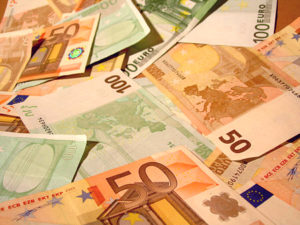 Friday’s trade saw EUR/USD within the range of 1.0826-1.0908. The pair closed at 1.0830, down 0.42% on a daily basis and marking a third consecutive trading day of losses. The daily low has also been the lowest level since May 27th, when the cross registered a low of 1.0818.
Friday’s trade saw EUR/USD within the range of 1.0826-1.0908. The pair closed at 1.0830, down 0.42% on a daily basis and marking a third consecutive trading day of losses. The daily low has also been the lowest level since May 27th, when the cross registered a low of 1.0818.
At 7:03 GMT today EUR/USD was up 0.16% for the day to trade at 1.0848. The pair touched a daily high at 1.0849 at 7:03 GMT.
Fundamentals
Euro area
Current Account
At 8:00 GMT the European Central Bank is to report on the regions current account for May. In April Euro zones seasonally adjusted current account produced a surplus at the amount of EUR 22.3 billion, which was 19.89% higher compared to the March figure.
The regions current account (without a seasonal adjustment) had a surplus of EUR 20.4 billion in April, which was 18.07% lesser compared to the March surplus figure.
The current account reflects the difference between savings and investments in the Euro area. It is the sum of the balance of trade, net current transfers (cash transfers) and net income from abroad (earnings from investments made abroad plus money sent by individuals working abroad to their families back home, minus payments made to foreign investors).
A current account surplus indicates that the net foreign assets of the region have increased by the respective amount, while a deficit suggests the opposite. A country/region with a surplus on its current account is considered as a net lender to the rest of the world, while a current account deficit puts it in the position of a net borrower. A net lender is consuming less than it is producing, which means it is saving and those savings are being invested abroad, or foreign assets are created. A net borrower is consuming more than it is producing, which means that other countries are lending it their savings, or foreign liabilities are created. An expanding surplus or a contracting deficit on the areas current account usually has a limited bullish effect on the euro.
German Buba Monthly Report
At 10:00 GMT Deutsche Bundesbank is expected to release its monthly report, containing a detailed analysis of current macroeconomic conditions as well as future forecasts.
Correlation with other Majors
Taking into account the week ended on July 19th and the daily closing levels of the major currency pairs, we come to the following conclusions in regard to the strength of relationship:
EUR/USD to NZD/USD (0.9593, or very strong)
EUR/USD to AUD/USD (0.6855, or strong)
EUR/USD to GBP/USD (-0.2977, or moderate)
EUR/USD to USD/CAD (-0.9249, or very strong)
EUR/USD to USD/JPY (-0.9515, or very strong)
EUR/USD to USD/CHF (-0.9654, or very strong)
1. During the examined period EUR/USD moved almost equally in one and the same direction with NZD/USD.
2. EUR/USD moved strongly in one and the same direction with AUD/USD during the past week.
3. The correlation between EUR/USD and GBP/USD was moderate.
4. EUR/USD moved almost equally in the opposite direction compared to USD/CAD, USD/JPY and USD/CHF during the period in question.
Bond Yield Spread
The yield on German 2-year government bonds went as high as -0.209% on July 17th, after which it slid to -0.215% at the close to gain 0.002 percentage point on a daily basis, while marking a second straight day of increase.
The yield on US 2-year government bonds climbed as high as 0.686% on July 17th, or the highest level since July 2nd (0.716%), after which it fell to 0.669% at the close to gain 0.008 percentage point for the day, while marking a second straight day of increase.
The spread between 2-year US and 2-year German bond yields, which reflects the flow of funds in a short term, increased to 0.884% on July 17th from 0.878% during the prior day. The July 17th spread has been the most notable one since July 13th, when the difference was 0.910%.
Meanwhile, the yield on German 10-year government bonds soared as high as 0.832% on July 17th, or the highest level since July 15th (0.847%), after which it slid to 0.790% at the close to 0.002 percentage point compared to July 16th.
The yield on US 10-year government bonds climbed as high as 2.374% on July 17th, after which it slipped to 2.347% at the close to lose 0.009 percentage point on a daily basis.
The spread between 10-year US and 10-year German bond yields narrowed to 1.557% on July 17th from 1.564% during the prior day. The July 17th yield difference has been the lowest one since July 14th, when the spread was 1.548%.
Pivot Points
According to Binary Tribune’s daily analysis, the central pivot point for the pair is at 1.0855. In case EUR/USD manages to breach the first resistance level at 1.0883, it will probably continue up to test 1.0937. In case the second key resistance is broken, the pair will probably attempt to advance to 1.0965.
If EUR/USD manages to breach the first key support at 1.0801, it will probably continue to slide and test 1.0773. With this second key support broken, the movement to the downside will probably continue to 1.0719.
The mid-Pivot levels for today are as follows: M1 – 1.0746, M2 – 1.0787, M3 – 1.0828, M4 – 1.0869, M5 – 1.0910, M6 – 1.0951.
In weekly terms, the central pivot point is at 1.0951. The three key resistance levels are as follows: R1 – 1.1077, R2 – 1.1323, R3 – 1.1449. The three key support levels are: S1 – 1.0705, S2 – 1.0579, S3 – 1.0333.





